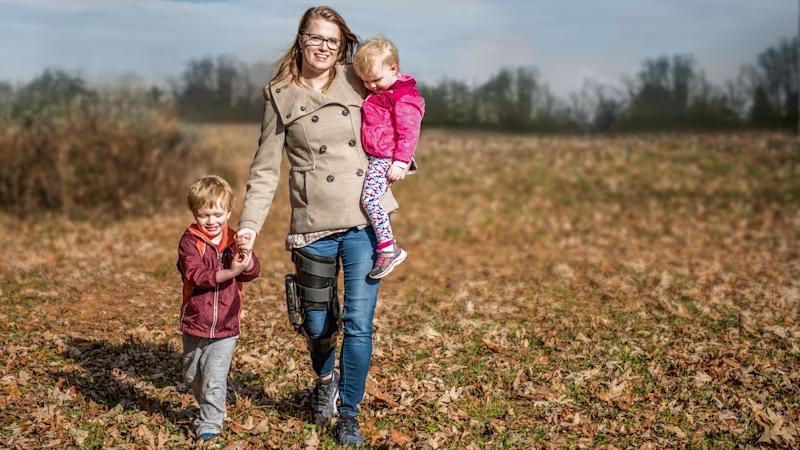Desgaste de la columna vertebral
A menudo, la edad y diversos factores externos son los causantes de un desgaste de la columna vertebral. Una órtesis puede descargar la espalda durante la vida diaria y protegerla tras una operación.
Causas, síntomas y tratamiento
El desgaste de la columna vertebral se desarrolla a lo largo de un período de tiempo prolongado. A menudo, el proceso de desgaste se inicia en la zona del disco intervertebral. Una carga intensa y una edad avanzada son las causas principales de un desgaste de los segmentos vertebrales.
Órtesis y correajes de Ottobock

Indication
Considerable wear and tear with degradation of the vertebral segment structures and their function is referred to as degenerative spine disease.
Causes
The causes are mainly related to age and other external factors. Years of heavy physical work, for example, can lead to changes in the spine that are indicative of wear and tear. A person’s individual predisposition, sports and their intensity, smoking and obesity influence wear and tear as well. Pain and discomfort can develop gradually over the course of years.
The 24 vertebrae making up the human spine and the intervertebral discs between them are divided into three sections: The cervical spine (seven vertebral bodies), the thoracic spine (12 vertebral bodies) and the lumbar spine (five vertebral bodies). The vertebral segment forms the smallest functional unit of the spine. It consists of the intervertebral disc with the adjacent vertebral bodies, the respective vertebral joints and the corresponding ligament structures. The fourth section, the sacrum, consists of segments that have ossified.
Initial signs of degeneration usually occur in the area of the intervertebral disc. Since the intervertebral disc is not supplied directly by vessels, but indirectly by diffusion, maintaining it depends on genetic and external factors. Increased strain on the spine, for example, due to increased physical work, sitting activities that are not compensated for, inappropriate biomechanical stresses or congenital malpositions, may mean that the continuous supply of nutrients to the intervertebral disc cannot be maintained. The ability of the intervertebral disc to retain water declines as a result. The height of the intervertebral disc decreases as a result.
The reduction in the intervertebral disc height leads to instability of the spine that gradually increases, and the function of nerves may be restricted as well. The body first helps itself by attempting to stabilise the spine through the increased formation of vertebral body bones. This is unsuccessful in many cases, leading to wear and tear of the small vertebral joints. These degenerative changes, either individually or in combination, lead to pain and/or a loss of function in the areas supplied by the segments.
Diagnosis
Degeneration of the spine is diagnosed by the doctor after taking a detailed medical history and assessing the findings, often with the support of imaging procedures.
Symptoms
The symptoms of degenerative spine disease usually develop over an extended period of time and are manifested by spreading or acute pain. The mobility of the back is reduced, and an inflammatory reaction in the vertebral joints is common. Sensation and/or motor functions can also be disturbed, occasionally to the extent that the individual has abnormal skin sensations and signs of paralysis due to constriction of the branching nerve cords. The severity of the limitations varies, ranging from a minor impairment of fine motor functions to complete, flaccid paralysis of certain muscle groups. Bladder and rectal control are reduced in rare cases.
The spinal canal may become constricted with increasing age due to years of wear and tear as well as thickening of the joints. This may be manifested in what are known as osteophytes and ossification in the area of the spine. This can lead to the ankylosis of vertebral joints due to bone growth on the joint caused by wear and tear.
Therapy
Depending on the degree of severity, therapy is initially conservative and takes the form of physiotherapy and orthoses. Medications are administered in many cases.
An operation is considered where there is a loss of motor function and/or sensation.
Spinal orthoses are used in conservative therapy to relieve the affected area of the back as well as in post-operative follow-up treatment.
The illustrated products represent treatment examples. Many different factors determine whether a product is actually suitable for you and whether you are capable of taking full advantage of the functionality of the product. Key aspects include your physical condition, fitness and a detailed medical examination. Your doctor or O&P professional will also decide which treatment is best suited to you. We’re here to support you.
Volver a la vida cotidiana: en 3 pasos hasta la órtesis de Ottobock
- Aquí encontrará un resumen de las órtesis y correajes que pueden ser adecuados para usted. Lleve consigo esta lista la próxima vez que acuda al médico.
- Consulte a su médico cuál de las órtesis es la más adecuada para su cuadro clínico. Seguidamente, su médico le extenderá una receta para la órtesis correspondiente.
- Acuda con la receta a una ortopedia. Allí recibirá su nueva órtesis después de haberse adaptado con precisión a sus medidas corporales.
